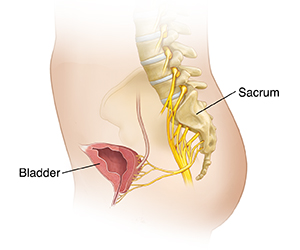Understanding Testing for Sacral Nerve Stimulation
Understanding Testing for Sacral Nerve Stimulation

Before sacral nerve stimulation is done, you need a trial or test procedure to see if it will work. This is called percutaneous nerve evaluation (PNE). During PNE, the healthcare provider puts temporary electrodes, or leads, in the nerves in your sacrum. The sacrum is the lowest part of your spine. It is connected to your pelvis.
After the leads are placed, the provider connects them to a pulse generator. This external device sends signals to the leads. When you turn it on, it stimulates the nerves in your bladder. It helps you control when you urinate.
Why sacral nerve stimulation is done
PNE is done to see if sacral nerve stimulation may help with your bladder problems. It is often done after other treatments, such as medicine, don’t work.
How testing for sacral nerve stimulation is done
PNE is often done in an outpatient facility. That means you can leave shortly after it is done. During the procedure:
You lie face down on an exam table.
You are given medicines so you don’t feel any pain. They may also make you sleepy.
The healthcare provider finds the right place to put the leads in your sacrum. He or she may use fluoroscopy to do so. It’s a type of X-ray imaging.
The provider injects a needle into the correct spot. He or she then puts a lead through the needle.
The provider checks that the lead is in the correct place. The needle is removed.
The provider tapes the part of the lead outside of your body to your skin. It is then connected to the pulse generator.
Risks of testing for sacral nerve stimulation
Movement of the lead
Pain
Infection
Updated:
June 21, 2018
Sources:
Al-Sannan B, et al. The Role of Sacral Nerve Stimulation in Female Pelvic Floor Disorders. Current Obsteric Gynecological Report. 2013;2:159-68., Banakhar M, et al. Challenges in Sacral Neuromodulation. In: Carrillo-Rutz, editor. Topics in Neuromodulation Treatment: InTech; 2012. p. 35-62., Gleason JL. Cystoscopy and Other Urogynecologic Procedures. Obstetrics and Gynecology Clinics. 2013 December 1;40(4): 773-85., Groen J, et al. Sacral Neuromodulation as Treatment for Refractory Idiopathic Urge Urinary Incontinence: 5-Year Results of a Longitudinal Study in 60 Women. Journal of Urology. 2011 September 1;186(3):954-9., Lai-Fung L, et al. Sacral Nerve Stimulation for Neurogenic Bladder. World Neurosurgery. 2016 June 1;90:236-43.
Reviewed By:
Greenstein, Marc A, DO, FACOS,Image reviewed by StayWell medical illustration team.,Ziegler, Olivia, MS, PA